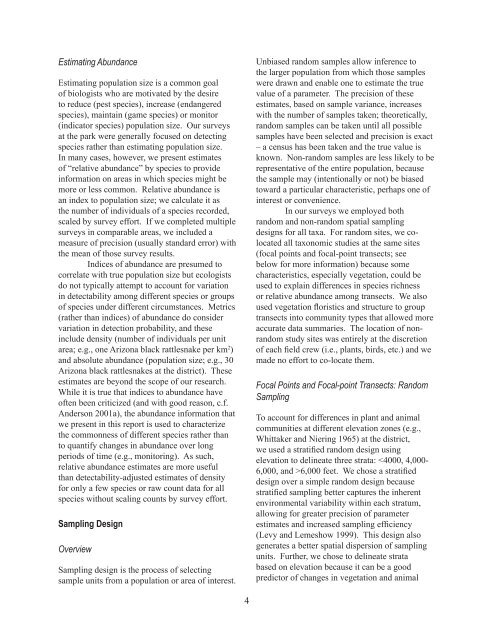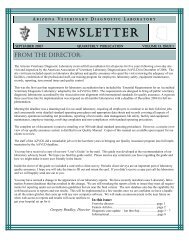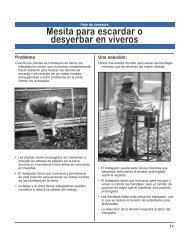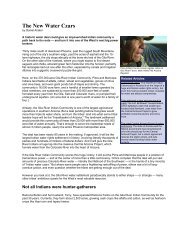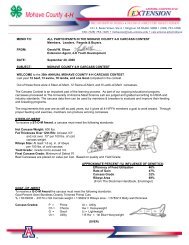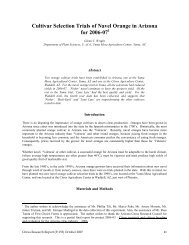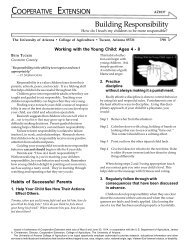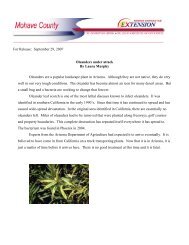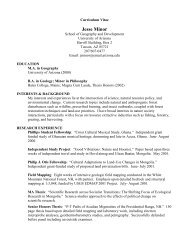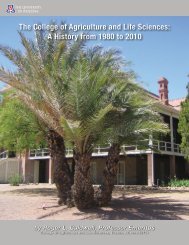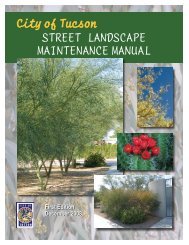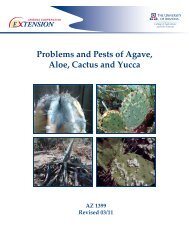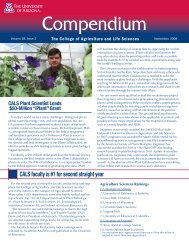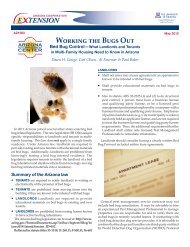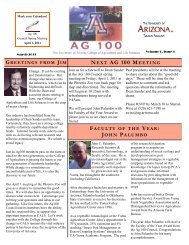Details - CALS Networking Lab - University of Arizona
Details - CALS Networking Lab - University of Arizona
Details - CALS Networking Lab - University of Arizona
You also want an ePaper? Increase the reach of your titles
YUMPU automatically turns print PDFs into web optimized ePapers that Google loves.
Estimating Abundance<br />
Estimating population size is a common goal<br />
<strong>of</strong> biologists who are motivated by the desire<br />
to reduce (pest species), increase (endangered<br />
species), maintain (game species) or monitor<br />
(indicator species) population size. Our surveys<br />
at the park were generally focused on detecting<br />
species rather than estimating population size.<br />
In many cases, however, we present estimates<br />
<strong>of</strong> “relative abundance” by species to provide<br />
information on areas in which species might be<br />
more or less common. Relative abundance is<br />
an index to population size; we calculate it as<br />
the number <strong>of</strong> individuals <strong>of</strong> a species recorded,<br />
scaled by survey effort. If we completed multiple<br />
surveys in comparable areas, we included a<br />
measure <strong>of</strong> precision (usually standard error) with<br />
the mean <strong>of</strong> those survey results.<br />
Indices <strong>of</strong> abundance are presumed to<br />
correlate with true population size but ecologists<br />
do not typically attempt to account for variation<br />
in detectability among different species or groups<br />
<strong>of</strong> species under different circumstances. Metrics<br />
(rather than indices) <strong>of</strong> abundance do consider<br />
variation in detection probability, and these<br />
include density (number <strong>of</strong> individuals per unit<br />
area; e.g., one <strong>Arizona</strong> black rattlesnake per km 2 )<br />
and absolute abundance (population size; e.g., 30<br />
<strong>Arizona</strong> black rattlesnakes at the district). These<br />
estimates are beyond the scope <strong>of</strong> our research.<br />
While it is true that indices to abundance have<br />
<strong>of</strong>ten been criticized (and with good reason, c.f.<br />
Anderson 2001a), the abundance information that<br />
we present in this report is used to characterize<br />
the commonness <strong>of</strong> different species rather than<br />
to quantify changes in abundance over long<br />
periods <strong>of</strong> time (e.g., monitoring). As such,<br />
relative abundance estimates are more useful<br />
than detectability-adjusted estimates <strong>of</strong> density<br />
for only a few species or raw count data for all<br />
species without scaling counts by survey effort.<br />
Sampling Design<br />
Overview<br />
Sampling design is the process <strong>of</strong> selecting<br />
sample units from a population or area <strong>of</strong> interest.<br />
4<br />
Unbiased random samples allow inference to<br />
the larger population from which those samples<br />
were drawn and enable one to estimate the true<br />
value <strong>of</strong> a parameter. The precision <strong>of</strong> these<br />
estimates, based on sample variance, increases<br />
with the number <strong>of</strong> samples taken; theoretically,<br />
random samples can be taken until all possible<br />
samples have been selected and precision is exact<br />
– a census has been taken and the true value is<br />
known. Non-random samples are less likely to be<br />
representative <strong>of</strong> the entire population, because<br />
the sample may (intentionally or not) be biased<br />
toward a particular characteristic, perhaps one <strong>of</strong><br />
interest or convenience.<br />
In our surveys we employed both<br />
random and non-random spatial sampling<br />
designs for all taxa. For random sites, we colocated<br />
all taxonomic studies at the same sites<br />
(focal points and focal-point transects; see<br />
below for more information) because some<br />
characteristics, especially vegetation, could be<br />
used to explain differences in species richness<br />
or relative abundance among transects. We also<br />
used vegetation floristics and structure to group<br />
transects into community types that allowed more<br />
accurate data summaries. The location <strong>of</strong> nonrandom<br />
study sites was entirely at the discretion<br />
<strong>of</strong> each field crew (i.e., plants, birds, etc.) and we<br />
made no effort to co-locate them.<br />
Focal Points and Focal-point Transects: Random<br />
Sampling<br />
To account for differences in plant and animal<br />
communities at different elevation zones (e.g.,<br />
Whittaker and Niering 1965) at the district,<br />
we used a stratified random design using<br />
elevation to delineate three strata: 6,000 feet. We chose a stratified<br />
design over a simple random design because<br />
stratified sampling better captures the inherent<br />
environmental variability within each stratum,<br />
allowing for greater precision <strong>of</strong> parameter<br />
estimates and increased sampling efficiency<br />
(Levy and Lemeshow 1999). This design also<br />
generates a better spatial dispersion <strong>of</strong> sampling<br />
units. Further, we chose to delineate strata<br />
based on elevation because it can be a good<br />
predictor <strong>of</strong> changes in vegetation and animal


